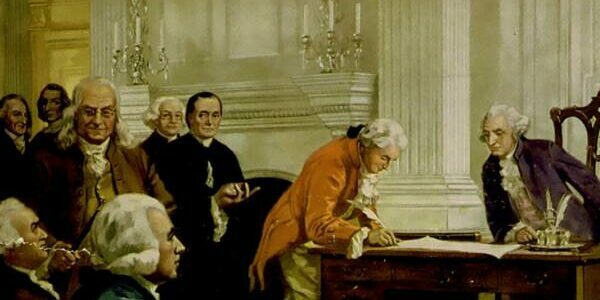The Other Father of the Constitution
When one thinks of the Founding Fathers, the “big six” usually come to mind: George Washington, Benjamin Franklin, John Adams, Thomas Jefferson, James Madison, and Alexander Hamilton. Their faces have been branded on coins and banknotes; they have been immortalized in motion pictures, video games, and Broadway musicals; and countless books have been dedicated to their lives, ideas, and political accomplishments. The same cannot be said for Gouverneur Morris, whose name carries only a faint presence in the American consciousness.
For Dennis C. Rasmussen, a professor of political science at Syracuse University, this is a problem that must be addressed. In his new book, The Constitution’s Penman, he seeks to pluck Morris out of obscurity by analyzing the formative role he played in shaping the Constitution and defining the ends of the American experiment. This thorough yet accessible work provides both a compelling overview of Morris’ life and a robust study of his political vision. More than that, it offers a rigorous challenge to the popular myth that the Constitution was merely an instrument of white supremacy developed to protect the interests of affluent, male slaveholders. Rasmussen makes clear that, in actuality, the Constitution was an extraordinarily democratic creation premised on lofty moral principles. By analyzing Morris’ life, in all its successes and contradictions, Rasmussen celebrates the ideals of liberty on which America was established.
What’s most striking about The Constitution’s Penman is how comfortable it is to read. An academic examination of a relatively unknown historical figure could easily be a dry, interminable slog, but Rasmussen’s prose is lively and unpretentious. He has a talent for distilling complex theoretical concepts into clear, engaging sentences, and his paragraphs are free from the clutter of unnecessary detail. Though Rasmussen leans toward his subject, his writing attends to both the strengths and deficiencies of Morris’ character in a balanced fashion, and he avoids referencing contemporary political affairs even when opportunities to do so glaringly present themselves. While discussing Morris’ views on how the president should be elected, Rasmussen notes that Morris “trusted the common people’s judgment in this regard more than almost anyone else at the [Philadelphia] Convention”; he even went so far as to argue that “if the people should elect, they will never fail to prefer some man of distinguished character, or services.” Mercifully, we’re spared a banal joke at the expense of Donald Trump, or a diatribe about the decline of presidential candidates.
This is not to say that Rasmussen’s style is humorless. On the contrary, he has a droll wit that feels appropriate given the colorful nature of his subject. It would be difficult for anyone interested in Morris not to write with a degree of levity considering his propensity for almost comically unfortunate accidents. As an undergraduate at King’s College, which later became Columbia, Morris’ right arm was permanently scarred after a kettle of boiling water was overturned on it. Later, in 1780, his left leg was replaced with a peg after his carriage crashed into a post. The end of his life came when he attempted to remove a blockage in his urinary tract with a whalebone from a corset; in Rasmussen’s words, he took “a page full of italics, capital letters, and exclamation points from the do-not-try-this-at-home handbook.”
In a book that could have solely concerned the intricacies of political theory, it’s enjoyable to find that these more ludicrous elements of Morris’ life are represented. They are far from the only unflattering details included by Rasmussen to humanize his subject. Morris, it turns out, was a highly educated child of aristocratic parents who was driven by intellectual interests throughout his life. But he was also a rakish character with an appetite for hedonism. He stood “well over six feet tall in an era when the average American man stood closer to five and a half feet,” and was “further graced with charisma, a keen sense of humor, and confidence to spare.” These attributes gave him great success with women, and he delighted in pursuing new affairs wherever he went. In one instance, Rasmussen describes how, after encountering Dolley Madison at a party, Morris determined that she was “open to seduction”—a vague reference to “[passing] the Evening with Mrs. Maddison” in his diary leaves it unclear if they were ever more than mere acquaintances. Morris’s other libidinous escapades are wryly observed; Rasmussen tells us that Morris had “the most intimate and protracted romantic tie of his life” with the French countess Adélaïde de Flahaut—“with the possible exception of his marriage.”
Thankfully, Morris’ political views are explored with greater seriousness than his attitudes to sex. Rasmussen focuses on the role Morris played in the design and ratification of the Constitution at the Philadelphia Convention. His thesis, essentially, is that Morris deserves significantly more credit for molding the document and the character of the United States than history has tended to grant. We learn that Morris was a man of strong and often idiosyncratic opinions; he argued that certain facets of American government should take on a form far removed from what we recognize today. He was an ardent nationalist who disapproved of federalism, spoke of “the splendor of the American Empire” before the American nation even existed, and believed the states should be merged into a singular entity. He opposed the idea of a democratically elected Senate, arguing instead for an “aristocratic body” whose members would possess great wealth and serve for life without pay. (One can only imagine the conspiracy theories that would stem from the Senate today if its members included Bill Gates, Jeff Bezos, and Mark Zuckerberg.) Likewise, he advocated a House of Representatives composed exclusively of “common people” to serve as a check on the influence of the wealthy.
But in other areas, Rasmussen reveals how Morris’ views profoundly influenced the structure of American government. Morris was committed to the idea that the American people should elect the president and fought harder for its adoption than any other delegate—he also prevented the presidency from being limited to a single term and lobbied exhaustively for George Washington to become the first occupant of the office. His influence on the judiciary was less substantial in the short term, but much of what he favored for that branch of government—judicial review, the independence of judges from Congress, and a system of federal courts—would eventually come to pass.
Though James Madison is typically referred to as the “father” of the Constitution, Rasmussen contends that Gouverneur Morris deserves equal “paternity.”
Morris was also a fervent opponent of slavery. He campaigned against the “nefarious institution” vigorously at the Convention, standing for his principles in the face of the wicked culture that surrounded him; his example would later inspire Abraham Lincoln and Henry Cabot Lodge. Rasmussen makes an especially incisive point on the issue, observing that Morris’ “ringing denunciations of slavery make it harder to accept the idea that the framers, as creatures of their times, simply did not know any better. Morris knew better, and he told them so.” It will take courage of this kind to preserve America’s traditions of liberty today against the illiberalism of the nationalist right and progressive left alike, and Morris’ example should continue to prove vital as the nation encounters new challenges.
Though James Madison is typically referred to as the “father” of the Constitution, Rasmussen contends that Morris deserves equal “paternity.” He explains that although the initial draft of the Constitution was written by a five-person committee, it was Morris who combined that draft with a list of alterations agreed on at the Convention to create the final document. “There is hardly a provision in the document that was not touched by Morris’s editing pen,” Rasmussen writes. His most sweeping changes included reducing the number of articles from twenty-three to seven—dedicating the initial tripartite to the legislature, executive, and judiciary was his idea—and simplifying the draft’s verbose language into “crisp, measured prose” so that the Constitution’s meaning could not be misconstrued.
Morris’ most pertinent contribution, however, was the Preamble. Originally, the Constitution began simply by listing the states involved in adopting it. Morris changed that opening into what we know today: a rallying cry of freedom that elegantly presents the purpose of the American experiment. By referring simply to “We, the people of the United States” rather than addressing each state by name, he ensured that future states could join the union without any complications. Moreover, by declaring that the United States had been founded to establish justice, insure domestic tranquility, secure the blessings of liberty, and so on, he “induced” all Americans to “bind themselves” to the pursuit of these ideals. The Constitution placed government in the hands of the American people alone, trusting them to act as their own sovereign. In the preamble, Morris provided this exceptionally democratic act with a moral framework to guide its course. Throughout American history, figures such as Lincoln, Frederick Douglass, and Susan B. Anthony have cited that framework to direct the nation toward the ultimate fulfillment of its founding principles.
It is difficult to place why a figure as colorful as Morris has disappeared into historical obscurity. Rasmussen is unable to offer a conclusive explanation, though he identifies a few possible reasons, among them that Morris’ licentious private life “undercuts the aura of gravitas that we expect from our venerable founders,” or that he “never wrote a substantial work for scholars to pore over” on the scale of The Federalist or Notes on the State of Virginia. But understanding his influence on the Constitution and its ethical underpinnings is essential to understanding the American project as a whole. Now, as they always have, Morris’ words in the Preamble clearly express what we are striving for as a nation. In our current moment—where America’s history is distorted by ideologues, its institutions are impaired by dysfunction and tribalism, and the Constitution itself is smeared as antiquated and rooted in racism—it is vital that we recall what our system of government was established to achieve. Looking to those words and the intent of the man who wrote them reminds us that today’s iconoclasts are wrong—the ideas on which the Constitution rests are not evil, but exceptionally moral.
Rasmussen, then, has produced an instructive and timely work of scholarship. The Constitution’s Penman offers an edifying study of the American Founding and a revealing look at one of its most consequential and unjustly neglected participants. But beyond that, it is a reminder of the indispensable values that the American people must work to uphold. Gratitude for what we have inherited is fundamental to a healthy society, and Rasmussen’s book affirms that Morris is especially deserving of it for the role he played in securing the American promise.


